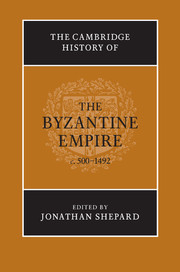Book contents
- Frontmatter
- General Introduction
- Part I The Earlier Empire c. 500–c. 700
- Part II The Middle Empire c. 700–1204
- 5 State of Emergency (700–850)
- 6 After Iconoclasm (850–886)
- 7 Religious Missions
- 8 Armenian Neighbours (600–1045)
- 9 Confronting Islam: Emperors Versus Caliphs (641–c. 850)
- 10 Western Approaches (700–900)
- 11 Byzantine Italy (680–876)
- 12 The Middle Byzantine Economy (600–1204)
- 13 Equilibrium to Expansion (886–1025)
- 14 Western Approaches (900–1025)
- 15 Byzantium and Southern Italy (876–1000)
- 16 Belle Époque or Crisis? (1025–1118)
- 17 The Empire of the Komnenoi (1118–1204)
- 18 Balkan Borderlands (1018–1204)
- 19 Raiders and Neighbours: The Turks (1040–1304)
- Part III The Byzantine Lands in the Later Middle Ages 1204–1492
- Glossary (Including some Proper Names)
- Genealogical Tables and Lists of Rulers
- List of alternative place names
- Bibliography
- Picture Acknowledgements
- Index
- References
17 - The Empire of the Komnenoi (1118–1204)
from Part II - The Middle Empire c. 700–1204
Published online by Cambridge University Press: 28 March 2010
- Frontmatter
- General Introduction
- Part I The Earlier Empire c. 500–c. 700
- Part II The Middle Empire c. 700–1204
- 5 State of Emergency (700–850)
- 6 After Iconoclasm (850–886)
- 7 Religious Missions
- 8 Armenian Neighbours (600–1045)
- 9 Confronting Islam: Emperors Versus Caliphs (641–c. 850)
- 10 Western Approaches (700–900)
- 11 Byzantine Italy (680–876)
- 12 The Middle Byzantine Economy (600–1204)
- 13 Equilibrium to Expansion (886–1025)
- 14 Western Approaches (900–1025)
- 15 Byzantium and Southern Italy (876–1000)
- 16 Belle Époque or Crisis? (1025–1118)
- 17 The Empire of the Komnenoi (1118–1204)
- 18 Balkan Borderlands (1018–1204)
- 19 Raiders and Neighbours: The Turks (1040–1304)
- Part III The Byzantine Lands in the Later Middle Ages 1204–1492
- Glossary (Including some Proper Names)
- Genealogical Tables and Lists of Rulers
- List of alternative place names
- Bibliography
- Picture Acknowledgements
- Index
- References
Summary
Between the death of Alexios I Komnenos and the establishment of the Latin empire of Constantinople, eight emperors ruled in the eastern Roman capital. Their reigns were as successful as they were long: under John II Komnenos (1118–43) and Manuel I Komnenos (1143–80) Byzantium remained a wealthy and expansionist power, maintaining the internal structures and external initiatives which were necessary to sustain a traditional imperial identity in a changing Mediterranean world of crusaders, Turks and Italian merchants. But the minority of Manuel’s son Alexios II Komnenos (1180–83) exposed the fragility of the regime inaugurated by Alexios I. Lateral branches of the reigning dynasty seized power in a series of violent usurpations that progressively undermined the security of each usurper, inviting foreign intervention, provincial revolts and attempted coups d’état. Under Andronikos I Komnenos (1183–5), Isaac II Angelos (1185–95), Alexios III Angelos (1195–1203), Alexios IV Angelos (1203–4) and Alexios V Doukas (1204), the structural features which had been the strengths of the state in the previous hundred years became liabilities. The empire’s international web of clients and marriage alliances, its reputation for fabulous wealth, the overwhelming concentration of people and resources in Constantinople, the privileged status of the ‘blood-royal’, the cultural self-confidence of the administrative and religious elite: under strong leadership, these factors had come together to make the empire dynamic and great; out of control, they and the reactions they set up combined to make the Fourth Crusade a recipe for disaster.
- Type
- Chapter
- Information
- The Cambridge History of the Byzantine Empire c.500–1492 , pp. 627 - 663Publisher: Cambridge University PressPrint publication year: 2009
References
- 1
- Cited by

